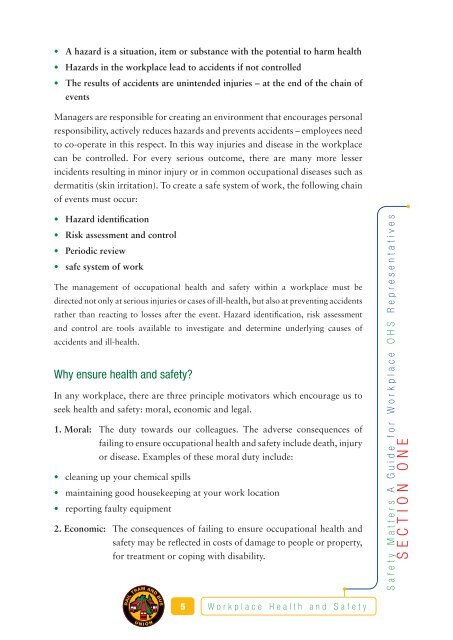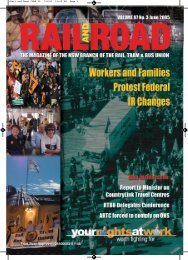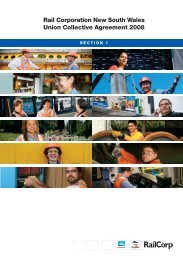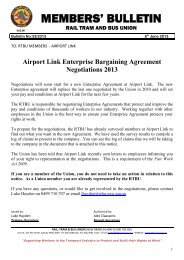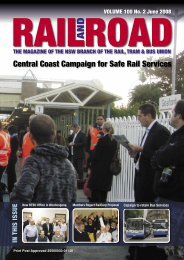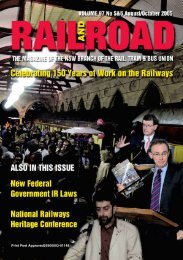Safety Matters - Rail, Tram and Bus Union of NSW
Safety Matters - Rail, Tram and Bus Union of NSW
Safety Matters - Rail, Tram and Bus Union of NSW
You also want an ePaper? Increase the reach of your titles
YUMPU automatically turns print PDFs into web optimized ePapers that Google loves.
• A hazard is a situation, item or substance with the potential to harm health<br />
• Hazards in the workplace lead to accidents if not controlled<br />
• The results <strong>of</strong> accidents are unintended injuries – at the end <strong>of</strong> the chain <strong>of</strong><br />
events<br />
Managers are responsible for creating an environment that encourages personal<br />
responsibility, actively reduces hazards <strong>and</strong> prevents accidents – employees need<br />
to co-operate in this respect. In this way injuries <strong>and</strong> disease in the workplace<br />
can be controlled. For every serious outcome, there are many more lesser<br />
incidents resulting in minor injury or in common occupational diseases such as<br />
dermatitis (skin irritation). To create a safe system <strong>of</strong> work, the following chain<br />
<strong>of</strong> events must occur:<br />
• Hazard identification<br />
• Risk assessment <strong>and</strong> control<br />
• Periodic review<br />
• safe system <strong>of</strong> work<br />
The management <strong>of</strong> occupational health <strong>and</strong> safety within a workplace must be<br />
directed not only at serious injuries or cases <strong>of</strong> ill-health, but also at preventing accidents<br />
rather than reacting to losses after the event. Hazard identification, risk assessment<br />
<strong>and</strong> control are tools available to investigate <strong>and</strong> determine underlying causes <strong>of</strong><br />
accidents <strong>and</strong> ill-health.<br />
Why ensure health <strong>and</strong> safety?<br />
In any workplace, there are three principle motivators which encourage us to<br />
seek health <strong>and</strong> safety: moral, economic <strong>and</strong> legal.<br />
1. Moral: The duty towards our colleagues. The adverse consequences <strong>of</strong><br />
failing to ensure occupational health <strong>and</strong> safety include death, injury<br />
or disease. Examples <strong>of</strong> these moral duty include:<br />
• cleaning up your chemical spills<br />
• maintaining good housekeeping at your work location<br />
• reporting faulty equipment<br />
2. Economic: The consequences <strong>of</strong> failing to ensure occupational health <strong>and</strong><br />
safety may be reflected in costs <strong>of</strong> damage to people or property,<br />
for treatment or coping with disability.<br />
<strong>Safety</strong> <strong>Matters</strong> A Guide for Workplace OHS Representatives<br />
SECTION ONE<br />
RAIL<br />
TRAM AND BUS<br />
5<br />
Workplace Health <strong>and</strong> <strong>Safety</strong><br />
U N<br />
I O N


